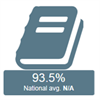 |
The score tells you how much progress pupils made between the end of Key Stage 4(GCSE) compared to other pupils across England who got Similar results when they were 11 years old. As 0 is the national average, a score above zero and an upwards arrow means pupils made more progress, on average than other similar pupils.
A negative score and a downwards arrow does not mean no progress, but less progress than similar pupils across England. The score is based on up to 8 approved qualifications. Most Schools in England score between -1 and +1. A score of +1 basicallymeans that on average, pupils achieve one grade more than pupils of a similar starting point. A score of -1 means they achieve one grade less.
|
|---|
 |
This score is based on how well pupils have performed in 8 key subjects (including English, maths, 3 qualifications including sciences, computer science, history,geography and languages and 3 additional approved qualifications.)Each GCSE is given a point score ranging from G = 1 to A* = 8 and attainment 8 is the average score per pupil. |
|---|
| 5 A*-C GCSEs or 9-4 (or equivalent) inc. English and Maths |
This is the percentage of pupils at the school who achieved 5 GCSEs at grades A*-C or 9-4 including the core subjects, English and maths. |
|---|
| GCSE Grade C or better in English and Maths |
This is the percentage of pupils at the school who achieved Grace C or better in the core subjects, English and maths. |
|---|
| A Level progress score GCSE to A Level |
This score shows how much progress pupils made between the end of Key Stage 4 (GCSE) and Key Stage 5 (A Level) compared to other pupils across England who got similar results at GCSE. As 0.0 is the national average, a score above zero and an updwards arrow means pupils made more progress on average than similar pupils.
A negative score and a downwards arrow does not mean no progress, but less progress than similar pupils across England.The majority of schools have progress scores between -2 and +2.
|
|---|
Pupils achieving AAB or higher at A Level inc.
two facilitating subjects. |
This is the percentage of pupils achieveing three A Levels, graded at least AAB in ‘facilitating subjects’.Facilitating subjects are the ones commonly needed for entry to universities. These are: biology, chemistry, physics, maths, further maths, geography, history, English literature and classical or modern languages. |
|---|
| A Level Average Point Score |
This is the total point score achieved by students in all academic qualifications (including A Level, AS, International Baccalaureate and Pre-U) divided by those students’ total number of academic entries. An A* is worth 60 points, A = 50, B = 40, C = 30, D = 20 and E = 10. |
|---|
| Average A Level Result |
This is the average grade at A Level, converted from the average point score per academic entry. |
|---|
 |
Gives you the number (as a percentage) of young people who went into either an apprenticeship or another form of structured work-based learning when they completed their school education. We show you the latest official validated data from the Department for Education (DfE). It is updated once a year. |
|---|
 |
Gives you the number (as a percentage) of young people who went into further education when they completed their school education. We show you the latest official validated data from the Department for Education (DfE). It is updated once a year. |
|---|